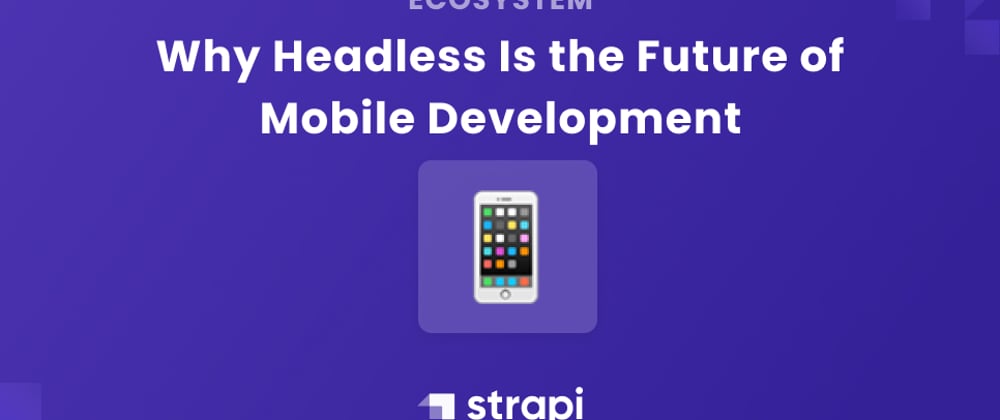In the world of mobile development, the content management system (CMS) reigns supreme as the go-to method for delivering content. As of January this year, nearly 65 million websites leveraged CMSes. You’ve likely heard of WordPress, Wix, and Squarespace, for example—three development platforms commanding immense market share.
This practice has also become commonplace during mobile application development. It’s no secret that this process is complicated—since teams must often develop for multiple devices and operating systems (i.e., iOS and Android). A centralized CMS acts as a reliable, time-saving backend, allowing developers to simultaneously push changes to multiple platforms.
There are two ways to accomplish this. The traditional, “headful” approach involves coupling databases to specific frontends. As a result, it’s easy for data to become siloed. Any updates across the application’s production lifetime (and versions) become that much more tedious. It’s also common for templates and themes to be outdated. That problem becomes compounded when different application architectures exist side-by-side.
Conversely, the headless approach involves both decoupling and consolidation. By simplifying the processes behind publishing content and updates, developers can streamline development while saving energy for other tasks.
Today’s software landscape is dominated by agility. Teams well-versed in headless development spend much less time extracting value from their products. Here, we’ll discuss the various mechanisms and benefits of going headless—and why it’s the future of mobile development.
What Is a Headless CMS?
To understand how a headless CMS works, first take a look at an app’s core components, all of which unite to power user experiences. The backend, behind-the-scenes component fetches data that’s either session-dependent or shared. Servers and databases store this information and send it back and forth between themselves and end users.
The frontend is where this data is displayed and arranged according to predesigned, coded layouts. This interactive layer is where users can authenticate credentials, sift through content, and make requests.
A headless application challenges traditional approaches by asking, “What if we could separate business logic, storage, and complex functions from the user interface?”
Storing information within the application itself is often unnecessary. Consequently, apps become needlessly bloated and consume more storage on user devices. Developers would also have to submit app updates if they wanted to refresh core content in a “headful” CMS. The editor would make changes within their CMS, push those to a specific website or application, after which they’d be displayed on the user’s machine.
In a headless implementation, APIs are critical to delivering similar changes to a whole host of client devices:
The headless system acts as a repository for vital content. You’re given more control over where your content ends up in relation to changing app layouts and workflows. This is a modern step forward from the traditional CMS when we consider the current services landscape.
Many organizations have implemented cloud-based microservices: applications composed of multiple loosely-coupled features, typically powered by APIs. Microservices employ a modular, piecemeal approach to application development—one where integrations mean everything. The movement toward API-powered content management is a logical development in lockstep with this trend.
The authoring and data layers are connected to the publishing API, which feeds into the rendering process. Note that rendering remains fundamentally separated from these application components, thus avoiding rigidity. Developers serve content by querying these APIs. Accordingly, certain user behaviors within applications (and mobile web apps) can influence how content is dynamically fetched in the background.
Hosting these core APIs in the cloud is essential to successful development. While editors still enjoy a CMS interface, the changes they make within it are unified.
Think of the content-publishing experience like flipping a master switch, as opposed to manually flipping ten switches in sequence to achieve similar results. Your headless CMS treats content as data, and this data is thankfully easy to transmit via HTTP (RESTful) web requests.
Many companies who make these systems actually offer them as SaaS applications—a nod to their flexibility and agnosticism to various tech stacks already leveraged in production.
Advantages of Headless for Mobile Development
We’ve touched on app updates and the tech-stack friendly nature of the headless CMS. Migrating away from one-size-fits-all, traditional approaches means not relying on your team members to bring specialized experience to be successful. You’re able to implement your own mobile content backend and really run with it.
However, that does not mean that you have to pour numerous hours into building a customized backend. That option is available, though teams can sidestep that expense with a reputable vendor.
Going headless is better (based on the richness of your application) than signing on with a mobile backend-as-a-service (MBaaS) provider. These methods don’t provide many mobile-friendly workflows and are inherently more “techy” than a typical headless CMS.
Today’s mobile applications are by-and-large a collective effort. An app must provide both rich functionality and business value to an organization. Stakeholders from marketing, DevOps, and beyond might desire daily editing access to publish content meaningful to them. The headless CMS is a user-friendly option for all team members regardless of technical knowledge.
Feel free to bring your own frontend stack in a headless environment. Mobile applications and web apps commonly use frameworks like React, Angular, VueJS, jQuery, and EmberJS for dynamic content rendering. These programming languages and libraries do the heavy lifting here, as opposed to the CMS. That frees the headless CMS up for other core publishing tasks.
Headless CMSes already excel at rapid editing. They’re also multi-channel friendly; supporting content production for internal apps, external apps, websites, and more. The headless approach maximizes productivity and reach—easily connecting your users with content, whether they’re on the couch, at the office, or catching public transit.
Headless also allows you to scale more effectively. The CMS acts as a single source of truth for your data, instead of spreading it amongst multiple locations. All members with access to that data can learn from it. You also don’t have to query numerous databases in order to fetch information for users. This equates to seamless functionality that feels more responsive to the user. Performance enhancements have been proven to markedly improve user perceptions of apps and services.
While we’ve been so focused on mobile applications, it’s crucial to highlight how headless applications can also be managed via mobile devices. Administrators and marketers are no longer tied to on-premises machines—an indispensable advantage in a world where telecommuting is becoming mainstream.
Whether you’re building a website, web app, managing products and services, or powering ecommerce experiences, headless CMSes are handy allies.
Pain Points of Existing Tools
Common platforms like Flutter, Ionic, and SwiftUI place more control in the hands of developers, but unfortunately, they can contribute a fair amount of bloat. Often, they don’t necessarily excel at building “native-looking” apps, and cater to certain OSes. For example, Apple’s SwiftUI is purpose-built for iOS, watchOS, and macOS, and in some opinions, lacks the polish of Ionic for Android.
While these toolkits can indeed be useful for building apps, they leave content management on the backburner. This is where an effective headless CMS can shine.
Conclusion
There’s little mystery behind why headless CMSes have gained so much steam recently. They’re centralized, performant, secure, and welcoming to users of most backgrounds. Despite relying on APIs, their GUIs simplify content management for all mobile applications. They cut down on bloat and reduce the overhead incurred by traditional applications on resource-strapped devices.
Are you looking to manage your content more easily and design APIs quickly? The Strapi headless CMS is a leading, open-source system based on Node.js. Our solution is fully customizable, developer-first, and 100 percent JavaScript—making it immediately familiar to most. Strapi is also committed to platform inclusivity, supporting iOS, Android, and progressive web apps.
Whether you’re a small team or enterprise customer looking for advanced permissions control, Strapi’s headless CMS has you covered. Delivering your content faster and keeping it updated has never been easier. We invite you to give Strapi a try today.
Hoping to learn more about mobile, headless development? Consider following Jahia Academy’s Headless Tutorial, or even explore how to build your own headless mobile CMS from scratch. If React is your jam, Blessing Krofegha offers a wonderful guide to headless web-app development, within Smashing Magazine.






Top comments (0)